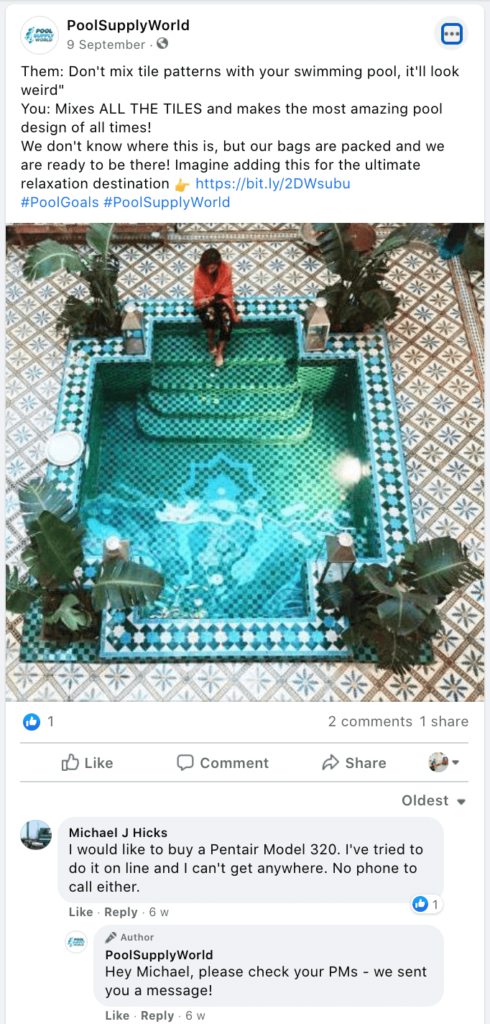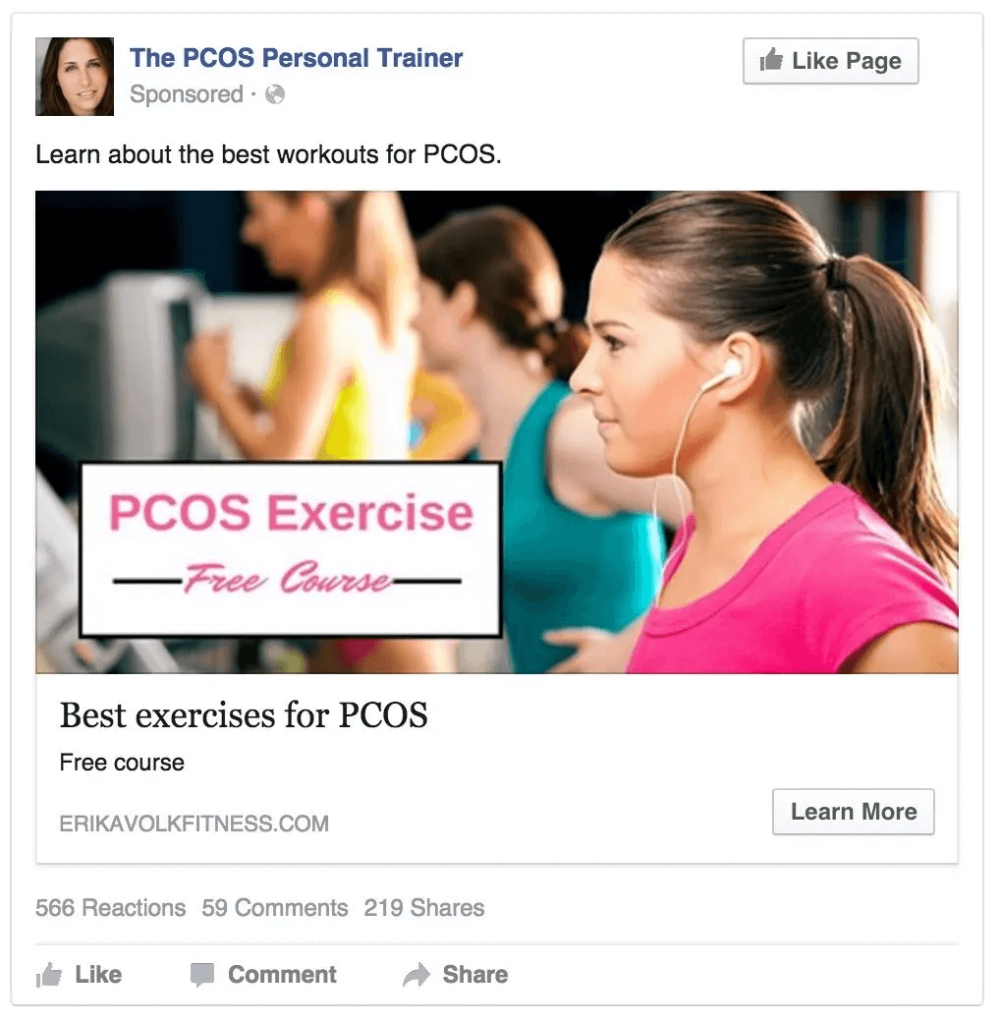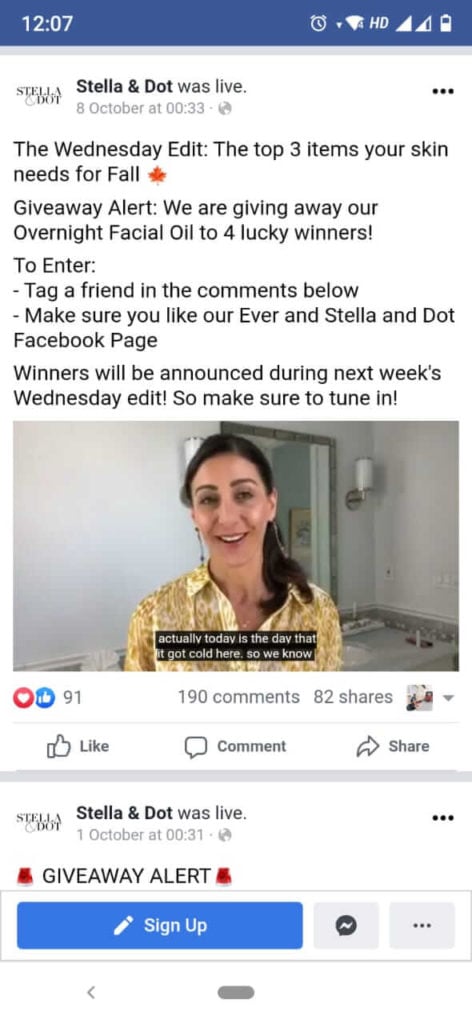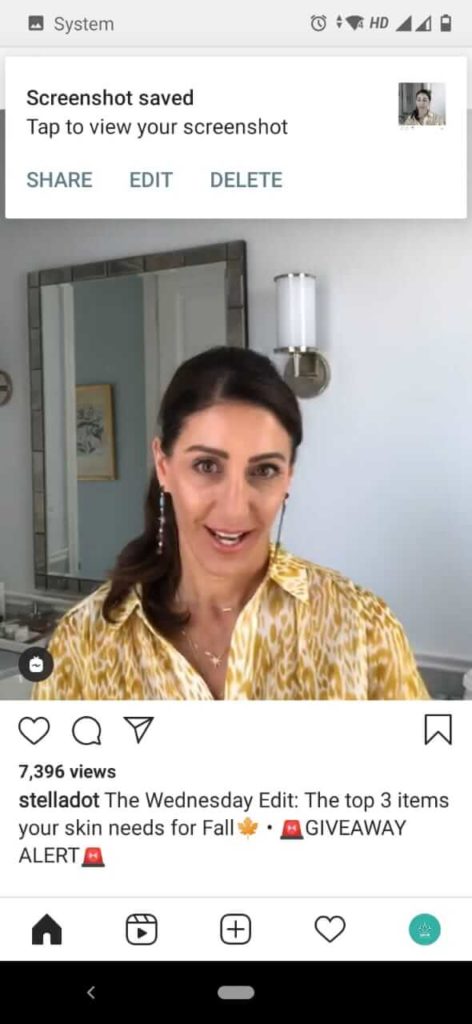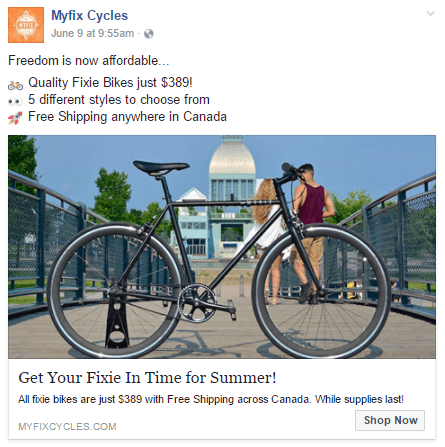When it comes to doing business in today’s digital marketplace, there’s no denying that Facebook is a force to reckon with.
For instance, you may have heard of this often-cited hyperbole: if Facebook were a country, it would be the most populous country in the world.
For perspective, that’s slightly less than the combined population of China and India—countries that account for nearly 37% of the world’s total population.
But even if you leave Facebook’s hulking size in terms of headcount, the social media giant has a formidable influence in today’s world.
For better or for worse, Facebook has single-handedly swayed election results,1 upended traditional media,2 and written the new rules of customer engagement.3
Small businesses in particular can benefit massively by using Facebook if they can tap into even a fraction of the business potential that the social media platform offers.
We’ll go over:
- Why use Facebook for your business?
- 6 ways to use Facebook for your business
How customer-obsessed is your business? Take the quiz to find out.
Why use Facebook for your business?
For startups, e-commerce stores, and all kinds of small businesses, there aren’t many platforms that hold as much power as Facebook does for marketing, sales, and customer service.
Let’s just say that you run a bootstrapped e-commerce website without a lot of marketing budget to spare. To keep things specific, let’s suppose that the average price of products listed on your website is $20.
By leveraging Facebook’s wide audience reach, you can do a host of things—like joining active Facebook groups to understand your target audience pain points to gather user feedback on your products or service—to increase your business potential.
Even if you reach out to 2,000 people in the process of your networking and convert 10% of those people into your monthly customers, here’s how much you stand to earn every month using this free method:
10% of 2,000 = 200
200 x $20 = $4,000
For a small business, that’s a pretty good reason to start using Facebook. And this is just one example of what you can do by taking advantage of the benefits of Facebook’s massive reach.
Facebook is a goldmine of opportunities for other use cases too, like customer support and community building. For instance, you can use a social listening tool or social CRM to monitor your brand’s online reputation or engage with customers.
Or, you can create an active fan page or a tightly knit Facebook group to build an audience you can later sell to.
Your target audience is likely already on Facebook—you just have to find them and start engaging with them.
6 ways to use Facebook for your business
From creating and managing a free-of-cost business page to luring back lost customers, here are six ways to use Facebook for business.
1. Create a Facebook page to drive traffic
From a business point of view, Facebook is the biggest real estate provider on the internet. And the great thing about creating your business page on Facebook is that it’s absolutely free of cost to do so.
Creating a Facebook page for your business is a great way to drive traffic and convert more people into customers.
In fact, Facebook is a proxy for many small businesses (e.g., tattoo studio, local car wash shop, craft stores, etc.) who don’t even have their own website. These businesses create their business pages on Facebook to hit on all their business goals like branding, sales, community building, and customer support.
If your business already has an online presence, that’s even better. You can use your Facebook business page to drive traffic—both to your website as well as your physical store (if you have one).
Here are a few ways on how you can tap into Facebook’s massive user base to drive traffic to your website/storefront.
- Add important business details like a website link, phone number, street address, and working hours:
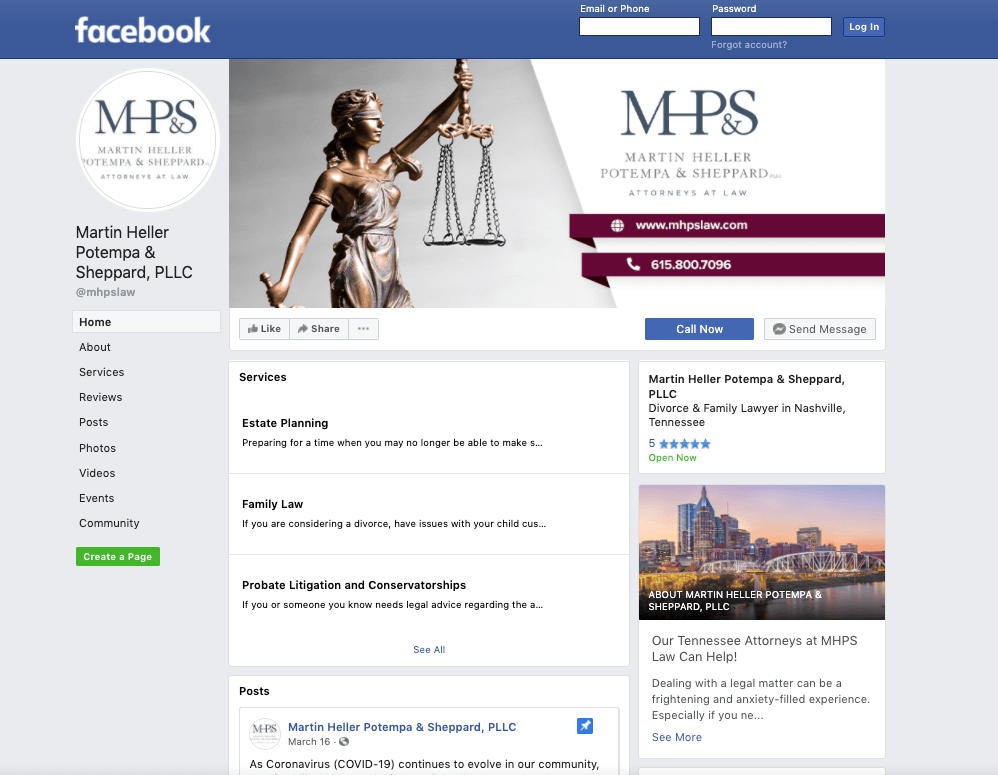
- Share your best content like blogs, videos, or infographics to get more people to discover your product/services.
- Add your WhatsApp and/or Instagram links to grow your followers count on those platforms.
- Go live on Facebook or schedule business events and attract more people to engage with your brand.
- Roll out new offers and run free marketing campaigns to promote your business.
- Post job ads to hire new talent for your business.
Let’s look at an example of how Cincinnati-based Pool Supply World uses Facebook to build its brand and grow traffic to its business.
Over the last few years, the admins at Pool Supply World’s Facebook page have followed a very simple strategy to promote their business on Facebook.
At least twice every day, they post fab-looking pictures of swimming pools and spas and share interesting tidbits about the upkeep of swimming pools. That’s it.
Because of their consistent brand exercise, they have built authority in their niche and have gained more than 95,000 page followers so far—many of whom are repeat customers.
They also list most of their products on Facebook Shops, a free-to-use mobile-friendly marketplace for businesses to create an online store on Facebook and Instagram for free.
Interested customers click on the products of their choice, which takes them to Pool Supply World’s checkout page, and buy the items directly from there.
Here’s an example of one of their Facebook posts:
2. Use Facebook to improve customer support
Gone are the days when customer support was just a physical department hidden behind corporate desks at the back of a business.
Today, your buyers expect customer service to be as easy as messaging a friend—and to get a response just as quickly.
And what better platform to deliver on that expectation than using Facebook: the place where users “friend” each other and “like” or “follow” their favorite brands.
Facebook—along with other digital channels—is a powerful medium to manage your customer support online, deliver excellent customer experience in a public forum, and earn social proof for being a great brand to do business with.
Of course, the flip side is true, too. If your customer support isn’t great, you risk it being widely known—quickly—in the social network.
But don’t worry, showcasing your quality customer support publicly and appeasing irate customers in private DMs aren’t mutually exclusive. Facebook lets you do both simultaneously.
For instance, you can use Messenger to chat with disgruntled customers and fight all kinds of customer support fires in private DMs. On the other hand, you can also encourage your brand’s fans to write a review for your brand—which appears in full public view on your Facebook page.
Here’s what else you can do—use a customer service software for Facebook like RingCentral Engage Digital™ to manage your Facebook, Messenger, Instagram, and WhatsApp interactions through a single omnichannel digital customer engagement platform:
RingCentral Engage Digital integrates with Facebook for Business and Facebook Messenger and lets you engage with your customers in real time through an easy-to-use unified dashboard:
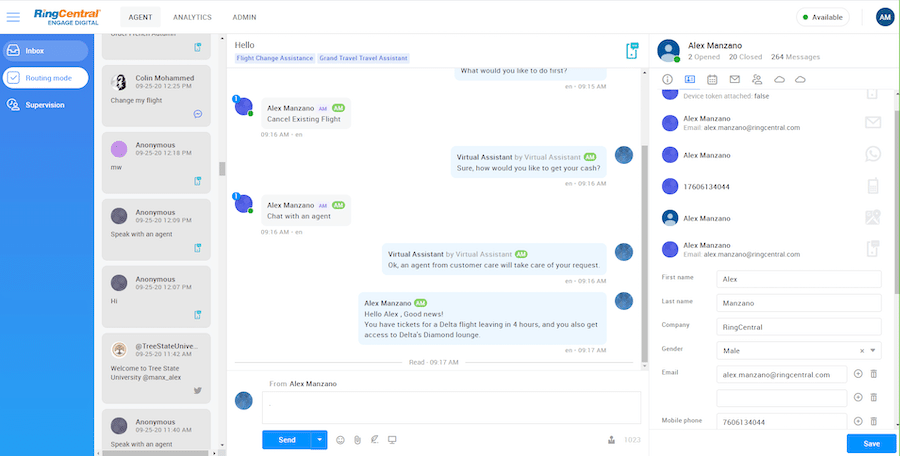
If you’re like most businesses and don’t have a ton of bandwidth to manage customer support, RingCentral Engage Digital can be a lifesaver. For example, its intelligent algorithm automatically routes the latest customer interactions from multiple digital channels to the right support agent without them having to jump from one social media platform to another
RingCentral Engage Digital doesn’t just support Facebook, WhatsApp, and Instagram either—it also helps your business manage your customer service across other major platforms like Apple Business Chat, Google searches, live chat, email, and even phone calls:

Many businesses are already using Facebook to improve their customer support online, whether it’s a large corporation like Orange that’s providing better customer care online or a local business like Lincoln Davies Building Supply:
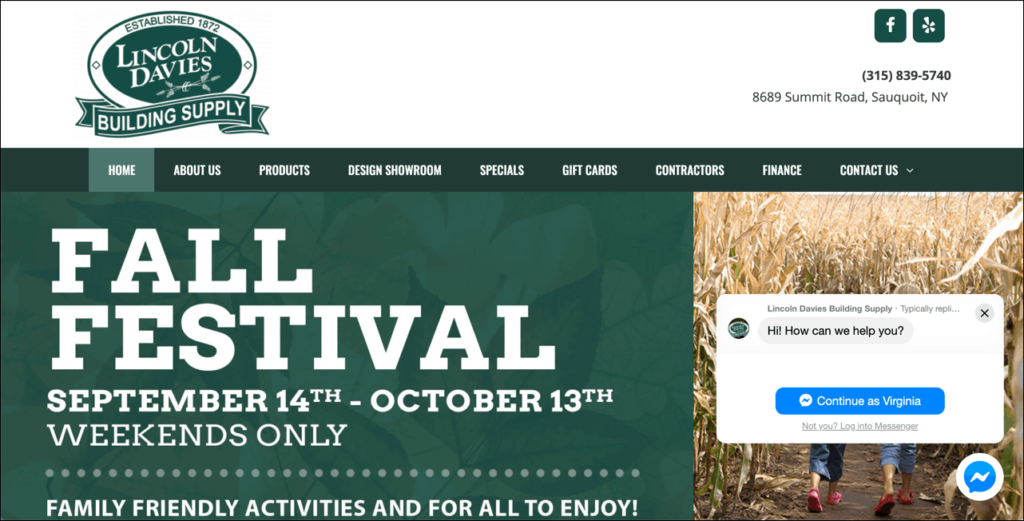
As you can see, the team at Lincoln Davies Building Supply has added Facebook Messenger on their website for their customers to reach customer service either through their website or through Facebook directly.
They also use a chatbot to handle customer service during offline business hours so that their customers aren’t left hanging.
People can either engage with the automated bot to get answers to their basic questions or type in their queries at the dead of the night knowing that the support team will respond when they see the message.
🕹️ Get a hands-on look at how RingCentral works by booking a product tour:
💰 You can also use this calculator to see roughly how much your business could save by using RingCentral to support your team’s communication with each other—and clients.
3. Run Facebook ads for immediate business returns
Facebook has been accused of subduing its organic reach in exchange for selling its ads platform to marketers.
And it has worked—nearly 78% of all American consumers report that they discover products for the first time on Facebook.4
The more immersed Facebook is becoming in our lives, the more Facebook ads are becoming more and more pervasive.
From a business perspective, there are three good reasons why you should spend on Facebook ads:
- They offer your ultra-specific audience targeting
- They fit your small business marketing budget
- They work like a charm
Targeting-wise, very few platforms are as specific as Facebook ads.
Want to market to vegan, single-parent households in St. Augustine, Florida? Done.
Or do you want to make your ads reach startup investors in Manhattan? No problem.
With Facebook ads, you can target based on geography, interests, user behavior, past interactions (with your Facebook page), and so on.
This is so much better—and saves you a lot of time and money—in contrast to the old alternative of “casting a wide net” only to funnel down your marketing to find a few right prospects.
Instead of wasting your time fishing through audiences who aren’t the right fit for you, Facebook’s laser-focused targeting works like magnet that only attracts your ideal customers.
In terms of budgeting and ease of execution, Facebook ads tend to fare much better than advertising on Google, Twitter, or LinkedIn.
Not just that, Facebook ads just work because they are highly customizable—you can tweak your ad strategy (without wasting a lot of money) until you find the approach that works best for your business. Tools like FB ads library can help you gain fresh ideas for your own campaign. With it you examine active ad content by other brands in your industry to see what works best and integrate that into your own advertisements.
Also, there are various kinds of Facebook ads to choose from:
- Video ads
- Photo ads
- Slideshow ads
- Carousel ads
- Canvas ads
- Dynamic product ads
Phew! That’s a mouthful.
And here’s a bonus advantage—you can connect your Facebook ads to Instagram ads in a single campaign, making sure you reach your audience on both platforms simultaneously.
Erika Volk—a fitness coach with polycystic ovary syndrome (PCOS) who runs the PCOS Personal Trainer website—offers an interesting perspective on how Facebook advertising for small business is irresistible.
When Erika decided to market her business on Facebook, she didn’t have spare change lying around to market her business. So her team decided to run a campaign worth $20/day—you know, just to test the waters.
They created an email course with an aim to use it as an incentive to attract website traffic, get people to join her email list, and convert the interested people as paying customers.
Here’s one of the ad creatives that they ran on Facebook:
By the end of the campaign, Erika’s fitness program had:
- 1,892 email subscribers (at the cost of $0.26 per subscriber)
- 11,850 unique website visitors in just one month
- Extremely low cost per visitor (6 cents) to her website page
Imagine the kind of impact video or carousel ads on Facebook can have on your business when a simple ad with an average-looking stock photo can drive so much value to a small business like Erika’s.
4. Amplify your reach by cross-posting to Instagram
One of the challenges that you might face as a small business owner is to manage your time juggling between many responsibilities like marketing, bookkeeping, inventory management, and so on.
And not all businesses have the luxury to have an eager intern to run their social media marketing. Thankfully, Facebook offers a glimmer of hope in the form of cross-posting your content to Instagram in order to bolster your social media campaigns.
Cross-posting simultaneously on Instagram is hugely beneficial because it:
- Saves you time
- Saves you from manual drudgery
- Saves you money
- Gets you a wider coverage
- Keeps your messaging consistent on both platforms
In short, cross-promoting on both platforms at once offers a better return on investment (ROI) for using Facebook marketing for small business.
But there are a few possible downsides too. For instance, if you don’t take your content’s formatting into account, your posts will come across as amateurish and half-hearted.
Facebook and Instagram users are pretty nuanced in what appeals to them, which means you might be forcing the wrong kind of content to at least one platform’s audience. That’s not a great way to run your marketing.
Instead, here are a few ideas to deal with situations like that.
Don’t overdo the cross-posting. Only cross-promote the best content pieces that you know the audience from both sides of the aisle will appreciate (e.g., flash sale announcements, contest alerts, value-packed blogs, etc.).
Also, review your posts’ performance on both platforms to base your future decisions. Analyze your post insights on Facebook and Instagram individually to take hints on which posts did well on both platforms and increase the frequency of such posts to make the best out of cross-posting.
For instance, visual posts are usually well-received by audiences on both platforms. So make sure your content is aesthetically appealing to look at.
Finally, use a scheduling tool like Meet Edgar or MissingLettr to preview your posts, manage hashtags, and preview images before you push them live.
If you have a busy support team, let RingCentral Engage Digital automatically assign tasks to support agents based on their competencies.
Stella & Dot—a style and accessories boutique company based out of San Bruno, CA—does Facebook+Instagram cross-posting really well.
They do live videos or post promotional content on both platforms to make sure the audiences on both platforms aren’t missing out on important updates from the brand.
Take a look at this post, for instance:
And here’s the cross-posted version on Instagram:
One thing to note is that they’re very careful about cross-posting only the best handpicked posts that they think are relevant to both their Facebook and Instagram followers.
5. Win back lost customers with retargeting ads
The conspiracy theorists among us believe that Facebook listens to our conversations—even offline ones. Worse still, some experts suspect that Facebook reads our minds.
Part of the reason for such theories to float on the internet is because Facebook is darn good with its remarketing ads.
Remarketing is an advertising technique that marketers use to display relevant ads to customers who have previously interacted with your website.
For example, let’s say you had a last-minute change of heart when buying the pair of jeans that you had almost checked out on Amazon. If Amazon used Facebook remarketing ads, the same pair of jeans will follow you on your Facebook news feed morning, noon, and night.
Facebook remarketing ads—which goes by the moniker Customer Audiences on Facebook—helps brands like Amazon widen their ads’ potential and improve their sales.
Here’s how it works. When you install Facebook pixels—short snippets of code—on your website, it enables Facebook to track the behavior of visitors on your website.
The pixels will help you remarket your products or services to prospects who slipped out of your website without completing their shopping. The pixels will also help you build audiences for future ad campaigns, track conversions, and tweak your ad strategy.
With good copywriting and strategic placement of such ads, you too can use Facebook remarketing ads to reduce abandoned carts and convert on-the-fence prospects to complete their half-done purchase.
Facebook remarketing isn’t much different from Google Ads remarketing. The only difference is that while Google depends on its partner platforms to distribute remarketing ads, Facebook limits the display of ads on its news feed.
Facebook remarketing ads are very popular among e-commerce brands. Here’s how the Canadian bicycle retailer, Myfix Cycle, used the ads to generate $15 for every $1 they spent on Facebook ads.5
After Myfix Cycle’s marketing team installed Facebook pixels on their website, they created two “customer audience” groups to target their ads to:
- People who visited their website in the last 14 days
- People who added an item to their shopping cart in the last 14 days
Then they ran ads to the above-mentioned groups at the frequency of five and seven times per customer.
Here’s how their remarketing ads look like:
By the end of their campaign, Myfix made $3,000 in revenue—increasing their sales potential by a huge margin compared to their traditional price per product that averaged at $300 per item.
6. Grow a community of true fans with Facebook groups
Facebook is not just great for amplifying your brand presence online, it also offers your brand opportunities to niche down.
You can discover one of such opportunities by creating a community of fans or followers to further your brand’s mission and assemble a group of like-minded people.
Obviously you can take advantage of this community by actively selling to them—running referral programs, announcing contests, upselling your products, and so on.
But building a community is often beyond such transactional business goals. A community is more about bringing a tribe of people together to achieve a common goal, to provide them a safe place to voice their ideas, and to set them up for success in their respective pursuits.
But what does your brand stand to gain from it? Nothing immediate or tangible—to be honest.
But if you build a community for the sake of helping people exchange powerful ideas, you will likely end up being a leader—not just a brand.
Building a community of raging fans will invariably help you earn organic brand ambassadors, cut your customer service overheads, and improve your customer retention.
For instance, faithful community members will take pride in being a member of your tribe and spread the word about your brand to the world.
They will also interact freely and help each other out—enabling you to deflect a fraction of your customer service traffic to the community.
And by helping them discover new ideas, tools, or techniques to succeed in achieving their goals, you will improve your customer success metrics and enhance customer loyalty.
But here’s the kicker, community building is hard. It takes time and consistent commitment to building a genuinely valuable tribe of people around your brand.
In his book, Tribes: We Need You to Lead Us, Seth Godin, a world-renowned marketer and author of 18 business books, explains simple steps to build a community.
- Gather the niche audience who share the same worldview as you
- Give them opportunities they can participate in
- Tighten the tribe by excluding people who don’t fit into your scheme
And here’s the best example from a brand that has created a Facebook group that fits the above description—Instant Pot.
Run by the pressure cooker company by the same name, the Instant Pot Facebook group is a big community of 2.5 million users—much bigger than the number of people who follow Instant Pot’s Facebook page (i.e., 267,000 people at the time of writing this post).
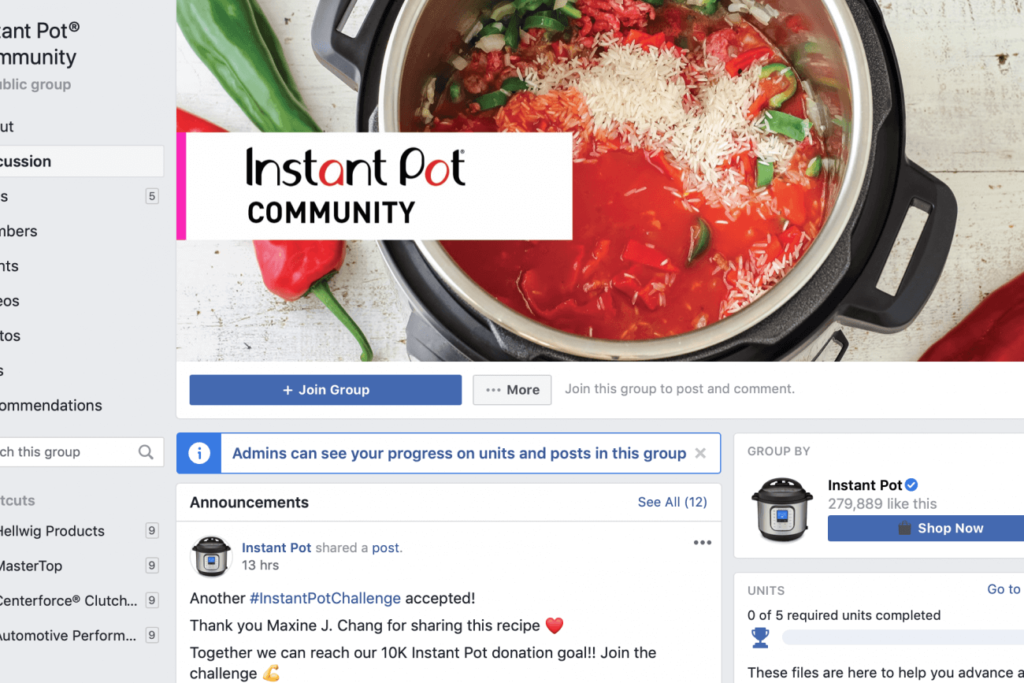
On a typical day, more than 10,000 users post in the Instant Pot group where members exchange food recipes, ask questions, or share their cooking stories.
The group enjoys an intensive engagement among its group members while the brand moderates the group interactions from a distance to make sure the quality of conversations is in good taste.
And oh, the brand also offers customer service to an extent although they are very particular about not promoting their brand to the community.
They do run occasional contests and give away their products to the winners to keep the group’s spirits high.
Instant Pot is a remarkable example of how to create a community that transcends a brand’s potential and turn it into a movement that uplifts the lives of thousands.
Using Facebook for business holds big promises
With so many opportunities to grow your brand, Facebook for small business is one of the best digital channels for you to make the most of. While it doesn’t cost much to get started with Facebook, the platform also scales to the level of your brand’s growth.
Go ahead, start leveraging the above-mentioned Facebook strategies for small business to improve your marketing, sales, and customer service.
1 washingtonpost.com/news/politics/wp/2018/03/22/all-the-ways-trumps-campaign-was-aided-by-facebook-ranked-by-importance/
2 edition.cnn.com/interactive/2019/02/business/facebook-history-timeline/index.html
3 netstorage.ringcentral.com/documents/facebook_miniguide.pdf
4 oberlo.com/blog/facebook-statistics
5 growtraffic.com/blog/2019/06/case-studies-retargeting-ads#Case_Study_2_Myfix_Cycles
Originally published Nov 13, 2020, updated Sep 05, 2023


